
Charaxes brutus, the white-barred emperor or white-barred Charaxes, is a butterfly of the family Nymphalidae. It is found in Africa.

Charaxes castor, the giant emperor or giant charaxes, is a butterfly of the family Nymphalidae. It is found throughout the Afrotropical realm below the Sahel.
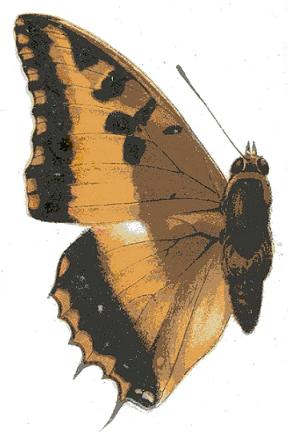
Charaxes druceanus, the silver-barred emperor or silver-barred charaxes, is a butterfly of the family Nymphalidae. It is found throughout tropical Africa.

Charaxes xiphares, the forest king emperor or forest king charaxes, is a butterfly of the family Nymphalidae. It is native to Afromontane forest in the eastern and southern Afrotropical realm.

Charaxes fulvescens, the forest pearl charaxes, is a butterfly in the family Nymphalidae.

Charaxes lucretius, the violet-washed charaxes or common red charaxes, is a butterfly in the family Nymphalidae.
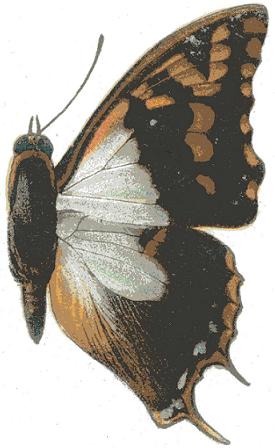
Charaxes lactetinctus, the blue patch charaxes, is a butterfly in the family Nymphalidae. It is found in Guinea, Ivory Coast, Ghana, Togo, Benin, Nigeria, Cameroon, the Republic of the Congo, the Central African Republic, the Democratic Republic of the Congo, Uganda, Kenya, Ethiopia and possibly Sudan.
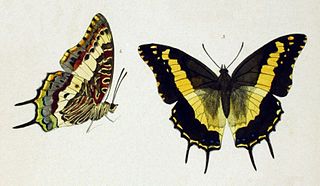
Charaxes hansali, the cream-banded charaxes, is a butterfly in the family Nymphalidae. It is found in Tanzania, Rwanda, Kenya, Uganda, Sudan, Ethiopia, Somalia, Saudi Arabia, Yemen and Oman.
Charaxes junius is a butterfly in the family Nymphalidae. It is found in Ethiopia and Sudan. The habitat consists of forests and woodland savanna.

Charaxes ansorgei is a butterfly in the family Nymphalidae. It is found in Sudan, the Democratic Republic of Congo, Uganda, Rwanda, Burundi, Kenya, Tanzania, Malawi and Zambia. The habitat consists of montane forest on altitudes between 2,000 and 3,000 meters. The larvae feed on Bersama abyssinica abyssinica, Bersama abyssinica englerana and Bersama paullinoides.It was once considered to be a very rare species but it is relatively common in dense and inaccessible montane forests

Charaxes pollux, the black-bordered charaxes, is a butterfly in the family Nymphalidae.
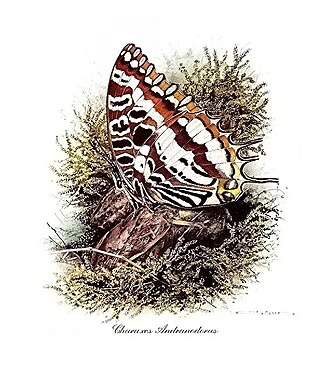
Charaxes andranodorus is a butterfly in the family Nymphalidae. It is found on Madagascar.
Charaxes lucyae is a butterfly in the family Nymphalidae. It is found in Tanzania.
Charaxes richelmanni is a butterfly in the family Nymphalidae. It is found in Cameroon, Gabon, the Republic of Congo, the Central African Republic, the Democratic Republic of Congo and Tanzania. The habitat consists of lowland evergreen forests.

Charaxes imperialis, the imperial blue charaxes, is a butterfly in the family Nymphalidae. It is found in Guinea-Bissau, Guinea, Sierra Leone, Liberia, Ivory Coast, Ghana, Benin, Nigeria, Cameroon, Equatorial Guinea, the Republic of the Congo, the Central African Republic, the Democratic Republic of the Congo, Rwanda, Uganda, Tanzania and Zambia.

Charaxes pythodoris, the powder-blue charaxes, is a butterfly in the family Nymphalidae. It is found in Sierra Leone, Ivory Coast, Ghana, Nigeria, Cameroon, Gabon, the Republic of the Congo, the Central African Republic, Angola, the Democratic Republic of the Congo, Ethiopia, Uganda, Kenya, Tanzania, Malawi and Zambia.

Charaxes anticlea, the small flame-bordered charaxes, is a butterfly in the family Nymphalidae. It is found in Senegal, Guinea-Bissau, Guinea, Sierra Leone, Liberia, Ivory Coast, Ghana, Togo, Nigeria, Cameroon, Gabon, the Republic of the Congo, the Central African Republic, Angola, the Democratic Republic of the Congo, Uganda, Kenya, Tanzania and Zambia.

Charaxes hildebrandti, the Hildebrandt's charaxes, is a butterfly in the family Nymphalidae. It is found in Sierra Leone, Ivory Coast, Ghana, Nigeria, Cameroon, Gabon, the Republic of the Congo, Angola, the Central African Republic, the Democratic Republic of the Congo, Uganda and Zambia. It is a rare and local species

Charaxes nichetes, the Manx charaxes or water charaxes, is a butterfly in the family Nymphalidae. It is found in Guinea, Sierra Leone, Liberia, Ivory Coast, Ghana, Benin, Chad, Nigeria, Cameroon, Gabon, the Republic of the Congo, the Democratic Republic of the Congo, the Central African Republic, Uganda, Tanzania, Malawi, Mozambique, Zambia, Zimbabwe and Angola.
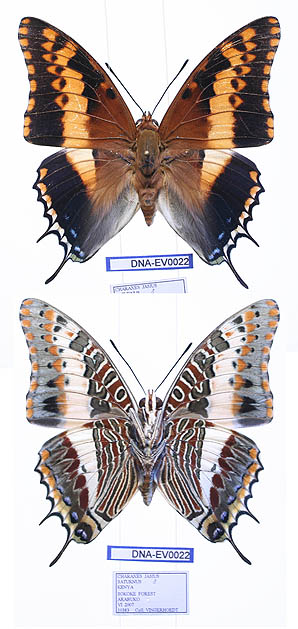
Charaxes saturnus, the foxy charaxes or koppie charaxes, is a butterfly that flies through most of the Savannah of the Eastern and Southern Afrotropical realm, and also occurs in suitable forest habitat locations including the forest belt of west-central Africa.

















